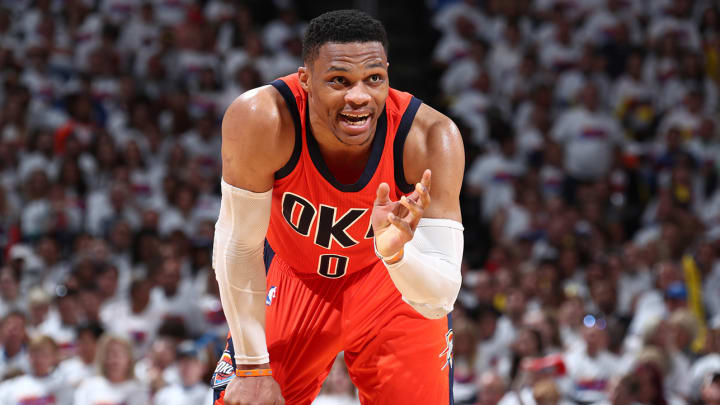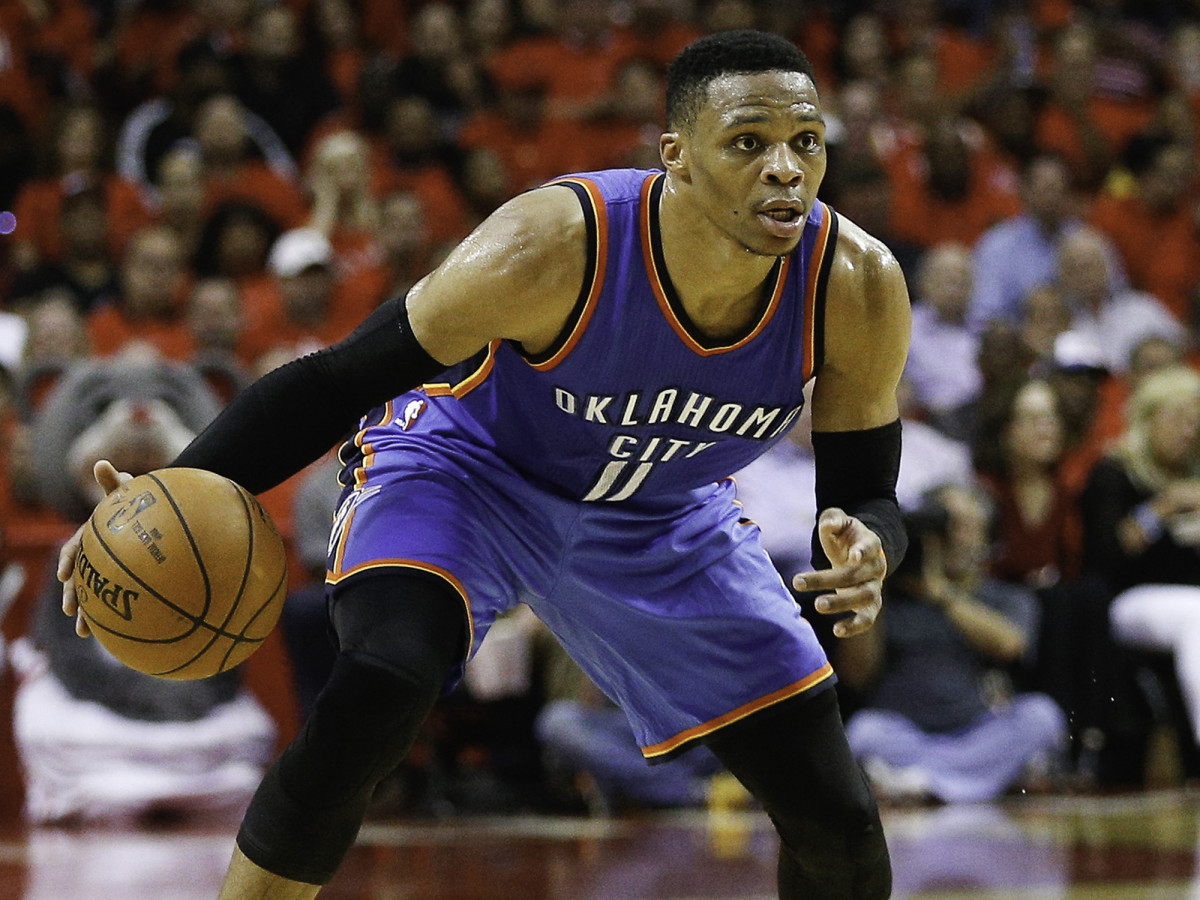NBA Off-Season Preview: Thunder Rebound From Kevin Durant Decision

While the NBA playoffs are still going, the 2017 off–season is rapidly approaching for many teams with massive decisions to make.CBA expert Danny Lerouxbreaks down the major challenges and opportunities for theOklahoma City Thunder in The Crossover's NBA Summer Preview series.
Oklahoma City had an unambiguously successful season after Kevin Durant left for the Warriors without compensation or much of a chance to replace him. Russell Westbrook had an MVP-caliber campaign, the Thunder made the playoffs and their key contributors are under team control moving forward. However, their off-season drama is far from over as Westbrook’s contract situation will be a major factor while the front office tries to re-tool with the goal of creating a successful, sustainable team around him with limited resources. General manager Sam Presti will need to be ready to again adjust on the fly but more likely he will have to make the absolute most out of their first round pick and Mid-Level exception to build a competitive team in a strong Western Conference.
Here are three key storylines to watch for the Thunder this off-season:

Russell Westbrook: It is exceedingly rare for a player who signed an extension less than a year ago to be one of the biggest stories heading into an off-season, but Westbrook being that unique case is fitting. While the talented guard added a year to his previous contract while also securing a raise for the 2016–17 season, the new Collective Bargaining Agreement allows him and former teammate James Harden to use the new Designated Veteran extension system since it did not exist last summer when they agreed to extensions. Since the Designated Veteran extension would entitle Westbrook to his maximum allowable salary for the maximum allowable duration, refusing to sign that deal would be a major red flag for the organization considering he would be a free agent after the upcoming season. As crazy as it sounds, Oklahoma City may have to consider trading the reigning MVP this summer since they cannot risk losing another superstar without receiving compensation.
Why Russ And OKC Put Their Trust In Sam Presti
Andre Roberson’s restricted free agency: While Roberson’s strengths and weaknesses have become abundantly clear over the last few seasons, this will be the first true measure of how NBA teams value him. That process will be fascinating, especially since the size of his offer sheet should affect Oklahoma City’s willingness to match. Unfortunately for them, it only takes one team falling in love to completely upend the calculus, as Portland learned with Allen Crabbe and Brooklyn last summer. To make matters worse, Roberson’s low cap hold and the Thunder’s other commitments create a circumstance where it would be almost impossible to replace the elite defender but untenable financially to keep him on a robust contract. Their best hope is that reduced cap space around the league and restricted free agency chill Roberson’s market, thus opening the door for a reasonable reunion.
Jerami Grant: Sam Hinkie continues to add to the NBA’s intrigue as he signed Grant to a team-friendly contract that creates a fascinating choice for Presti and the front office. If they pick up his incredibly cheap team option for next season, the athletic forward will be an unrestricted free agent next summer. Alternatively, they can decline that option and make him a restricted free agent this off-season, like the Rockets did with Chandler Parsons back in 2014. It would be a gamble since, like Roberson, it would only take one team making an irresponsible offer to ruin it, but there is also a chance they could bring Grant back on a very team-friendly contract for multiple seasons. The luxury tax is also a potential factor here as declining the option would mean a larger price tag for next season when the team is already expensive.
Potential Free Agents: Andre Roberson (Restricted), Taj Gibson (Unrestricted), Jerami Grant (Team Option, then Restricted), Semaj Christon (Non-Guaranteed), Nick Collison (Unrestricted) and Norris Cole (Unrestricted)
Likely Summer of 2017 Cap Space: None
Realistic Maximum Summer of 2017 Cap Space (using $101M estimate): None
2017 Draft Assets: Own first round pick (21st overall). Second round pick traded to Denver for Joffrey Lauvergne last August.
Potential Targets: No matter what, Oklahoma City’s biggest need is reliable shot creation outside of Westbrook. They scored a horrifying 97.4 points per 100 possessions with him off the floor and that has to change. With only exceptions to work with, a backup point guard like Ty Lawson, Jose Calderon or C.J. Watson could be enough to keep them afloat during the regular season. If Roberson leaves, the Thunder will also require a capable perimeter defender without adding a way to bring that player in. While a Thabo Sefolosha return would be possible, the pressing need for a point guard may push them towards less expensive options like Justin Holiday or David Nwaba if the Lakers decide to let him go.
The Legend Of Russ: Does MVP Even Matter?
Pressure Scale: 7. A vast majority of the front office’s stress can and likely will be relieved when Westbrook agrees to a Designated Veteran extension. Other issues like Roberson’s free agency and potentially negotiating an extension with Doug McDermott certainly matter but they do not alter the arc of the franchise nearly as significantly. This off-season could have also been dominated by restricted free agency for Victor Oladipo and Steven Adams, but Oklahoma City extended both of them last fall. Outside of Westbrook, the greatest challenge for Presti would be if ownership decides that the team needs to avoid the luxury tax next season. That edict would mean Taj Gibson is almost definitely gone, Kyle Singler could be waived using the stretch provision and Enes Kanter potentially moves to the trading block. It is entirely possible that will not occur, but the Thunder are very close to locking in a very expensive team with a largely stable salary cap.
State of the Franchise: Establishing a long-term identity. Surprisingly, it only took one season for the Thunder to find success without Durant. With many pieces of the 2016–17 team in place long-term, Oklahoma City could look similar for the next few seasons. However, the structure could also change due to choices in and out of their control. Ownership should figure out their willingness to pay the luxury tax before the madness starts, but Westbrook’s extension decision and Roberson’s offer sheet can and should affect their approach as well.
One of the more compelling questions surrounding the Thunder is how much they could change their core structure. Kanter is talented and on a reasonable contract, but it will be hard to trade centers this summer while Oladipo and Adams feel like pieces Presti intends to build around. Those four are the team’s only current salaries over $6 million and their other team-building options are the Mid-Level exception, about $5 million on a trade exception remaining from Ersan Ilyasova and possibly the Bi-Annual exception if they stay under the apron. While useful, those options work more as periphery adjustments than structural changes. Retaining Gibson would help but giving the veteran big man his expected salary makes the Thunder a luxury tax team for years to come without a clear path to title contention.
Oklahoma City thrived in surprising, exhilarating ways this season but will need an effective off-season for that playoff run to be a stepping stone to greater success.
